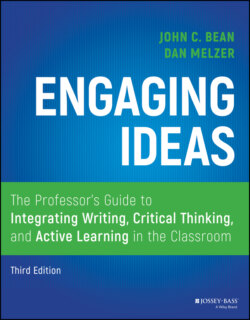Читать книгу Engaging Ideas - John C. Bean - Страница 19
What's New in the Third Edition?
ОглавлениеGiven this background on new scholarship and evolving teaching practices, we can now provide a succinct description of what is new in the third edition:
A new chapter (chapter 11) on using self‐assessment, reflection, and peer review to promote revision. This new chapter reviews the scholarship on reflection and peer review and shows how instructors can shift some of the responsibility for responding to student writing from themselves onto students.
A new chapter (chapter 16) on alternatives to traditional grading. This chapter reviews long‐standing critiques of traditional grading in pedagogical scholarship and shows how portfolios and contract grading can be viable alternatives for overcoming inequities and increasing students' motivation, effort, and engagement.
A revised chapter 3 on helping students think rhetorically. Influenced by insights from the teaching‐for‐transfer movement in first‐year composition, our revised chapter 3 now covers genre in more detail and connects genres more fully to the concept of discourse community.
A revised chapter 4 on formal writing assignments. Our revision focuses more heavily on placing formal assignments within authentic rhetorical contexts that include purpose, audience, and genre. It also emphasizes the wide range of genres (from academic/professional to personal/expressive) that are appropriate for formal assignments.
A revised and relocated chapter on grammar and sentence editing (now chapter 15, previously chapter 5). Our revised chapter now takes a consciously translingual approach to linguistic diversity and moves the chapter toward the end of the book. The chapter still emphasizes careful sentence editing, but in the context of the writer's purpose, audience, and genre.
A revised chapter 7 on reading. Influenced by recent scholarship on the reading practices of disciplinary experts, our revised chapter focuses on reading mindfully across a range of reading purposes, which can vary depending on whether one's purpose is to formulate a deep response to a text (common in the humanities) or to advance mastery of content knowledge (common in the sciences and professional fields).
A revised chapter 10 on teaching undergraduate research. Arguing that undergraduates should be assigned authentic research projects written in appropriate disciplinary genres, this chapter now focuses on teaching metacognitive understanding of authentic research across the disciplines and provides many new examples of research assignments and teaching strategies.
Deletion of the second edition chapter on essay exams. The writing‐across‐the‐curriculum movement has always been troubled by timed in‐class essay exams—either because exam questions often ask for memorized information and thus are low on Bloom's taxonomy or they require a high level of critical thinking, but short circuit the process of revision where the work of critical thinking occurs. Rather than devote a chapter to essay exams, we have relocated much of the second edition's advice to other chapters.
Throughout the book, many new examples and updated references. In almost every chapter, the third edition contains new examples of assignments, critical thinking tasks, and teaching practices drawn from across the disciplines, as well as more ethnically and linguistically diverse examples.
Throughout the book, many updated applications of instructional technology and rhetorical uses of social media. Wherever appropriate we have updated and expanded our coverage of classroom technology and the affordances of social media ranging from the emergence of new genres to the uses of memes, podcasts, and other multimodal assignments.
